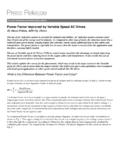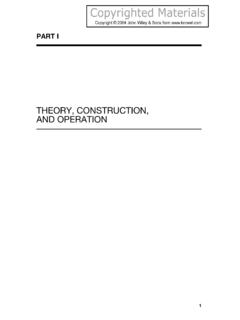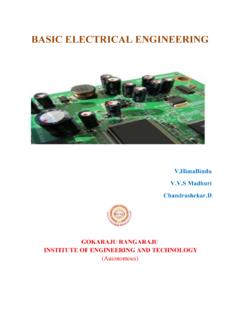Transcription of EDEXCEL NATIONAL CERTIFICATE/DIPLOMA UNIT …
1 EDEXCEL NATIONAL CERTIFICATE/DIPLOMA . unit 67 - further electrical principles . NQF LEVEL 3. OUTCOME 3. TUTORIAL 1 - SINGLE PHASE AC CIRCUITS. unit content 3. Understand the behaviour of single-phase alternating current (AC) circuits Series R, L and C alternating current (AC) circuits: current and phase angle in series combinations of RLC circuits (RL, RC, RLC); construction of phasor diagrams and relationship with voltage and impedance triangles for each of the three types of R, L and C combinations;. power factor (cos ) and power triangle apparent power (S = VI), true or active power (P =. VI cos ) and reactive power (Q = VI sin ); conditions for series resonance inductive reactance equals capacitive reactance (XL = XC); Q factor (voltage magnification) V 1 L.
2 Q L ,Q ,and its importance in high and low frequency circuits. V R C. Parallel: evaluation of the voltage, current and phase angle in parallel combinations of resistance, inductance and capacitance RL, RC, LC and RLC; construction of phasor diagrams for impedance and phase angle; conditions for parallel resonance in an RLC circuit supply current and voltage in phase;. L. Impedance at resonance dynamic resistance R D ; Q factor (current magnification). CR. I. Q C ; filter circuits high pass, low pass, band pass, band stop. I. It assumed that the student has studied the electrical and Electronic principles module. 1. 1. POWER FACTOR CORRECTION. Industrial users of electric power often place inductive loads on the supply in the form of large motors and transformers.
3 This may be regarded as an inductor in series with a resistor and produces a current that lags the supply voltage. The true power is that developed across the resistive load and is given by P = I2R and is measured in Watts. Consider a resistor in series with an inductor. The inductive voltage phasor leads the resistive voltage phasor by 90o. The resultant voltage is the supply voltage. The apparent power is the product of V and I and often stated as S = VI. This is not measured in Watts but in Volt Amps. V/I is the impedance Z and is given by Z R 2 X 2. The POWER FACTOR is the ratio of the true power to the apparent power and is defined as P I 2 R IR R. cos hence P = VI cos( ). S VI V Z. In order to reduce the power factor a series capacitor is needed to produce capacitive reactance equal and opposite to the inductive reactance.
4 Ideally XC = XL. This is obtained from the relationship XL /R = tan . Reactive power is defined as Q L VI sin . X. Z. WORKED EXAMPLE No. 1. An ac load takes kW of power from a supply 110V at 60 Hz. The current is 30 A. Determine the power factor and the size of a capacitor needed in series to correct it. SOLUTION. = True Power /Apparent Power = 2500/(110 x 30) = = cos-1( ) = cos-1 = True Power = I2R = 302 R = 2500 W. R = 2500/900 = . XL/R = tan = XL = R = . XC = = 1/(2 fC). C = 1/(2 x 60 x ) = F. 2. SELF ASSESSMENT EXERCISE No. 1. 1. A consumer takes 20 kW of power from an ac supply at 240 V and 50 Hz. Due to an inductive power factor, the current is 100 A. Determine the power factor and the size of a capacitor required to correct it.
5 ( F). 2. An electrical load comprises of a resistance of 100 and an inductor of H in series. The supply is at 240 V and 50 Hz. Determine the Power factor. ( ). 3. An ac supply to a consumer is at 220V and 50 Hz with a current of 20 A. It is found that there is a lagging phase angle of 20 o. Determine the Power Factor, the true power and the size of a capacitor that would make the power factor 1. ( , kW and 874 F). 3. 2. SERIES CIRCUITS. We know from previous studies that the relationship between current and voltage for any component is related as a ratio X = V/I. For a resistor this ratio is resistance R but for an inductor it is called inductive reactance XL and for a capacitor capacitive reactance XC.
6 Inductive reactance increases with frequency and is given by X L = 2 f L. 1. Capacitive reactance decreases with frequency and is given by X C . 2 f C. When current flows in an RLC circuit, the relationship between it and the resulting voltage is called the IMPEDANCE Z. V. Z . I. V and I are the resulting volts and current. Since reactance is V/I it follows that it is also a phasor. The phasor diagram for a series R L C. circuit may be drawn as shown with R drawn horizontally to make it easier. X XC . Z XL XC 2 R 2 and tan 1 L . R . WORKED EXAMPLE No. 2. A resistor of value 470 is connected in series with a capacitor of 22 F and an inductor of 50. mH and a voltage is applied across it. A current of 100 mA (rms) is produced.
7 Determine the impedance, the phase angle between the voltage and current and the applied voltage when the frequency is 50 Hz SOLUTION. XL = 2 fL = 2 x 50 x 50 x 10-3 = . XC = 1/2 fC = 1/(2 x 50 x 22 x 10-6) = . Z X L X C 2 R 2 2 4702 . XL XC 1 . tan 1 tan o R 470 . VS = I Z = x = V rms 4. SELF ASSESSMENT EXERCISE No. 2. 1. A resistor of value 4 is connected in series with a capacitor of 47 F and an inductor of 20. H and a voltage is applied across it. A current of 50 mA (rms) is produced. Determine the impedance, the phase angle between the voltage and current and the applied voltage when the frequency is 100 Hz. (34 , and V). 2. A resistor of value is connected in series with a capacitor of F and an inductor of 5.
8 MH and V rms is applied across the ends. Determine the impedance, the phase angle between the voltage and current and the rms current when the frequency is 1000 Hz. ( , and 204 mA). 3. PARALLEL CIRCUITS. The main point about parallel circuits is that the voltage is common to each and the current is different. It is often easier to use the idea of ADMITTANCE and CONDUCTANCE so this is defined next. ADMITTANCE and CONDUCTANCE. These are mainly used in the solution of parallel circuits. Conductance is the inverse of resistance and is denoted G. 1. G . R. It follows that IR = V G. Admittance is the inverse of impedance and is denoted Y. 1. Y . Z. It follows that I = V Y. Susceptance is the inverse of reactance and is denoted B.
9 1. B . X. It follows that IC = V BC for a capacitor and IL = V BL for an inductor. The units of Y, G and B are Siemens symbol S. 1 S = 1 -1. PARALLEL RESISTORS. The circuit shows two resistors in parallel. The parallel rule tells us 1 1 1 1. Z Alternatively or Y G1 G 2. 1 1 Z R R. 1 2. R1 R 2. 5. PARALLEL RESISTOR, INDUCTOR AND CAPACITOR. Consider the parallel circuit below. The voltage is common to all components but the current in the inductor is reactive and leads the voltage by 90 o and the current in the capacitor lags by 90 o. Since the current in the resistor is in phase with the voltage, the phasor diagram for the currents is like this. It is convenient to draw the phasors with IR horizontal and the resultant current is as shown.
10 The resultant current = I I L I C 2 I 2R. I XC . The phase angle is tan 1 L . R . If we substitute IR = V G and IL = V BL and IC = V BC. B BC . Y BL BC G 2 tan 1 L . 2. G . It also follows that we may represent G, B and Y as phasors. You should decide which method you prefer to use. The parallel circuit may be represented with G, B and Y as shown. WORKED EXAMPLE No. 3. For the three circuits shown below, determine the supply current and phase angle between the supply voltage and current when 50 V rms is applied. SOLUTIONS. (a) Y BL BC G 2 0 S. 2 2. I = VS x Y = 50 x = A. B BC 1 0 . tan 1 L tan o G . 6. (b) Y BL BC G 2 0 S. 2 2. I = VS x Y = 50 x = A. B BC 1 0 . tan 1 L tan o G . (c) Y BL BC G 2 S.

















